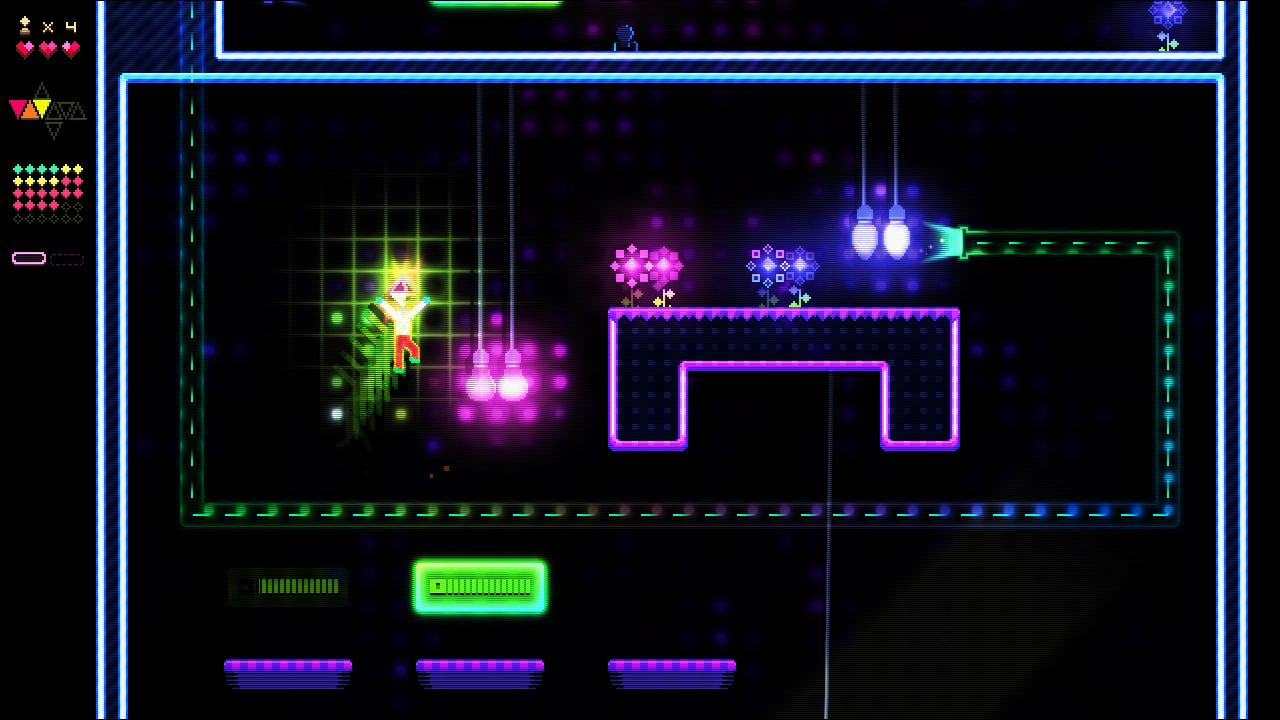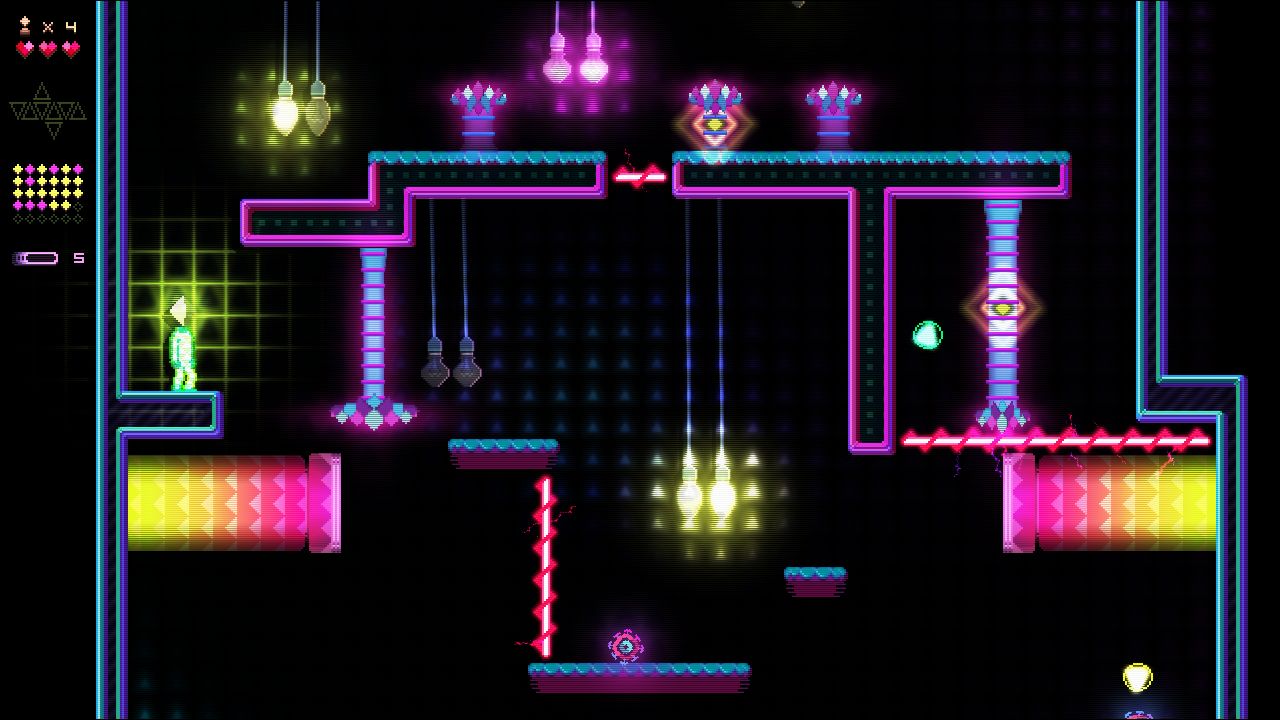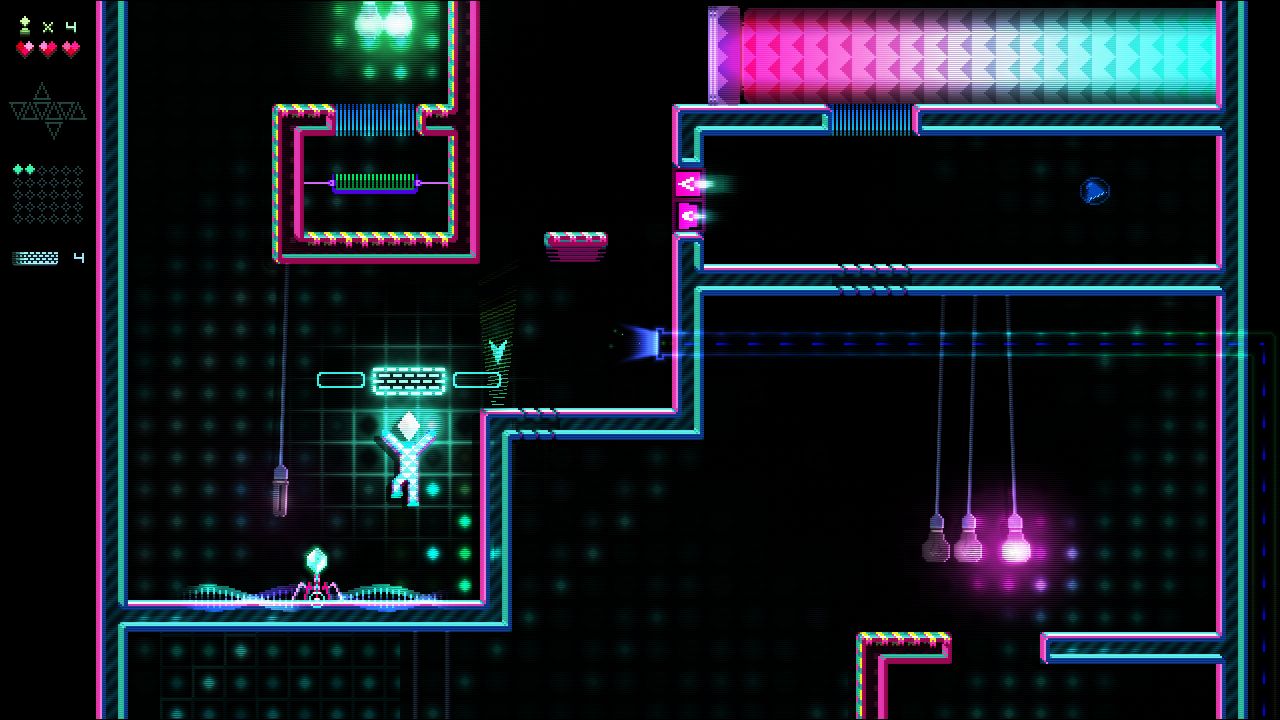Run out of platforms in Octahedron and you can just make your own
The psychedelic puzzle-platformer is all about experimenting with straightforward tools.
I hate to spoil a moment from the start of Octahedron, but it's too perfect an example of how this game works. You're tumbling down a dark tunnel, eternally falling like Alice heading to Wonderland, and for a while I thought this was just part of the introductory cutscene. Then I realized I could steer left and right as I fell, and when I tapped X suddenly a platform appeared beneath my feet and the game began.
Making platforms is what Octahedron is about. As you work your way up through the levels of its flashing disco underworld you can summon a limited number of your own temporary platforms to fill the gaps between the ones it gives you. The amount you have recharges when you touch one of the those existing ledges, so it's a game of plotting how to get from one safe point to the next—while geometric spiders and bats and red lights that pulse to the rhythm of its trance soundtrack try to get you.
There are plenty of complications (your platforms can slide horizontally, parts of the level furniture can be moved or vanished or destroyed), but Octahedron's prologue levels do a great job teaching you how to deal with the basics. It doesn't feel like education, it just presents you with things and lets you figure them out. And once it's done teaching, it gets hard.
The only thing it doesn't explain is the strangeness of its weird psychedelic dancefloor aesthetic, where collectible diamond flowers have to be freed from lightbulbs and you have an octahedron for a head. I asked its creator, indie developer and electronic musician Marco Guardia, but I'm still really none the wiser.

PC Gamer: You've been working on Octahedron since 2013. What was the original idea like? How different was it?
Marco Guardia: What was there from the beginning was the whole platform-making thing because that was the origin of the game. I had a couple of different ideas that I wanted to try, and one of the things I had written down that I wanted to try for Octahedron at the beginning was just 'a platformer about making platforms'. I didn't really know exactly what that meant but I figured I'm just gonna try this, I'm gonna try what this means. I started making a really simple prototype about making platforms and that was the beginning. Actually that prototype is in the special edition.
...maps that I found online of Mega Man, old Capcom platformers, Nintendo platformers, I printed them out and laid them out on the floor and just tried to figure out why do these levels work or why do they not work?
Marco Guardia
What was the inspiration, was it modern puzzle platformers, or more old-fashioned games?
The biggest gaming news, reviews and hardware deals
Keep up to date with the most important stories and the best deals, as picked by the PC Gamer team.
In terms of level design, the design philosophy in general, it was older games. The platform mechanic didn't really have inspiration from anything, for me it was a new idea. I knew that there were games where you draw elements of the level geometry or you draw platforms so that you can then walk on them but it's very different, a passive mechanic where you draw something then the character can jump on it. I wanted something that was immediate—where the character could jump then immediately make a platform. That was new but in terms of how you control the character, how it feels, the response, the feedback, the lag or the immediacy of the controls, no complications, no acceleration, no complicated acrobatics—that was inspired by Mega Man.
The first few months of development were spent studying old school level design so I printed out maps that I found online of Mega Man, old Capcom platformers, Nintendo platformers, I printed them out and laid them out on the floor and just tried to figure out why do these levels work or why do they not work? It's difficult to find good literature on classic 2D level design. There's a lot of good stuff out there about game design in general and 3D design but old school 2D stuff? That was hard to come by, so that was my solution to that predicament.
It does a good job teaching you how to play. I really felt like I was figuring things out myself when I was playing through that tutorial and the opening levels, learning new things one at a time. Was that a major goal?
Yeah! You're pushing my buttons man, that's exactly—in fact I would say that I spent about half the time designing a level, literally 50% is spent figuring out how to best teach the player what's going on and what he has to do. Making sure that it's the minimum amount of punishment for not understanding mechanics so that he doesn't feel like, 'Oh I shouldn't have died here' or 'I shouldn't have been hit.' That's one of my major things about level design in general. I want to make a game that's completely intuitive, has basically no text, no tutorial text—I have two lines of tutorial text in the game, really short, at the very beginning.

I wasn't actually expecting there to be story so I was surprised by that opening cutscene.
I kept having to push that with my publisher too. They were totally fine with that just at several points in the discussion it was like, 'Let's put some footage of the story into this trailer.' Or 'Let's put screenshots on the store with the story in it' and I always said no, I don't want that, I want people to have no idea this is part of the game and just get into it because it stylistically is very different from the rest of the game.
Smashing lightbulbs so that flowers grow out of the platform above them: where did that idea come from?
It was totally a pure design, mechanical thing. Very few things are motivated by aesthetic theme or idea that comes from anywhere else than trying to solve a design problem. I wanted an element a player could interact with that would be fun to enjoy on your way through a level. Question blocks or other types of blocks in Mario games, the grass in Zelda, that sort of thing that gives you a little bit of a reward. What was really important for me is that it wouldn't interrupt the flow of the player's movement through the level. This is one of my major gripes, in a lot of games that I love too, collectibles are things that are not 100% required that people who wanna have a great flow through a level and want to go fast through a level, they get punished for going out of their way to get those things.

It's the same with something as simple as Mario, which I know isn't necessarily about speeding through a level, but you stand still, you destroy a block, then you either chase whatever's coming out of the block or you jump on top to get the thing so it's a bit of a long interaction. I didn't want that. I wanted something that you could just walk past, the lightbulbs are in the background so you don't have to mess with them at all but you could destroy and destroying them didn't mean that you would have to stop, you'd just destroy them on your way.
I have absolutely no idea where that shape came from. It was there from the beginning, once I designed the character it was there.
Marco Guardia
My problem was that at first I just had diamonds falling from the lightbulbs to the ground, then I realized what this means is I have to go back to get them because they just fall behind me, right? I would get up to the platform, run back, get the diamonds and be on my way. This is already too much for me. I'm an impatient person, I just want to be on my way.
Then I thought, well, they have these cords, they're attached to the ceiling so why don't I make the diamonds just rise through those cords and emerge on the floor that they're attached to? I figured that's the direction you're going in because you're going up, so they're just going to be in your way. From the growing idea I thought, well, if they grow they should be plants or flowers. Basically that was it.
And the collectible pyramids? What are they about?
You need [to score] about 70-75% in each world to unlock the bridge to the next world, which is nothing, which is easy to do. You have to completely ignore a lot of lightbulbs not to get that. Starting from World 2 there's secret bridges that lead to an optional side thing that have bonus levels, which then lead to upgrades that are optional in the game and in order to build those bridges you don't need diamonds but you need those tetrahedrons or triangles. And that's all it's about really. You realize at some point, 'Oh wait, if I collect these I can get something extra and I can get extra levels out of them'. I didn't want to put that at the beginning because it's OK to ignore that, you don't need those upgrades to complete the game. But the levels are kinda cool and I like rewarding people with extra levels because the people who go out of their way to 100% a game, they're usually ones who like extra content.
What they are about in terms of aesthetics or the reason behind them… I made a few paper models to get them right, but an octahedron is made up of eight tetrahedrons, right? Eight pyramids essentially. They don't look exactly like in the game because the tetrahedrons that I use in the game are regular pyramids that have the same face on every side, but that's just a little creative liberty. If you cut an octahedron into eight pieces you would get literally those eight pieces that you collect in each level. Even the colors align, there's a little layout of triangles, right? And that's actually a paper model. If you printed that out you could cut that out, literally fold it and glue it together you get an octahedron that would look like the one that you have in the game exactly. The colors align. Why I did that I'm not really sure but it would be possible and it's accurate.
What is your obsession with octahedrons anyway?
That's a really good question. I became obsessed with them once I decided to make the main characters' head an octahedron which was there in the very first prototype, which is in the special edition. The very first idea for the character's head was a rotating square. Then I tilted it at 45 degrees and it looks like a diamond. Then I started looking up what other kind of shapes would fit that and then I went, 'Hey, octahedron!' I kind of liked that but I have absolutely no idea where that shape came from. It was there from the beginning, once I designed the character it was there. Everything came from that. The octahedron's part of the Platonic solids, there's five of them: there's tetrahedron; there's the cube; the octahedron; there's the dodecahedron; there's the icosahedron. All of these five important shapes in geometry, they're all in the game at some point. Some of them are really important as you'll see later on. But it just came from the original idea, that's all there is to it and I have no idea where that came into my head from.
Octahedron will be available on March 20.

Jody's first computer was a Commodore 64, so he remembers having to use a code wheel to play Pool of Radiance. A former music journalist who interviewed everyone from Giorgio Moroder to Trent Reznor, Jody also co-hosted Australia's first radio show about videogames, Zed Games. He's written for Rock Paper Shotgun, The Big Issue, GamesRadar, Zam, Glixel, Five Out of Ten Magazine, and Playboy.com, whose cheques with the bunny logo made for fun conversations at the bank. Jody's first article for PC Gamer was about the audio of Alien Isolation, published in 2015, and since then he's written about why Silent Hill belongs on PC, why Recettear: An Item Shop's Tale is the best fantasy shopkeeper tycoon game, and how weird Lost Ark can get. Jody edited PC Gamer Indie from 2017 to 2018, and he eventually lived up to his promise to play every Warhammer videogame.

